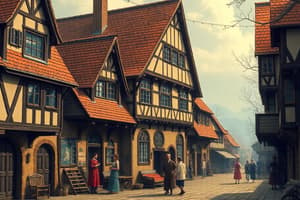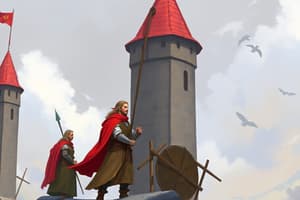Podcast
Questions and Answers
Que período histórico caracterizou o feudalismo en Europa occidental?
Que período histórico caracterizou o feudalismo en Europa occidental?
- Séculos IV a VIII
- Séculos IX a XV (correct)
- Séculos XVI a XVIII
- Séculos I a III
Cal foi unha das principais causas do xurdimento do feudalismo?
Cal foi unha das principais causas do xurdimento do feudalismo?
- A unificación dos reinos
- O aumento da poboación urbana
- A inseguridade e as invasións (correct)
- A desintegración do sistema mercantil
Quen era responsable da defensa dos territorios no sistema feudal?
Quen era responsable da defensa dos territorios no sistema feudal?
- As clases sociais máis baixas
- A nobreza e o clero (correct)
- Os comerciantes e artesáns
- Os monarcas únicos
Que tipo de economía predominaba no sistema feudal?
Que tipo de economía predominaba no sistema feudal?
Cal era o papel do rei na monarquía feudal?
Cal era o papel do rei na monarquía feudal?
Como se estabelecían as relacións de dependencia no feudalismo?
Como se estabelecían as relacións de dependencia no feudalismo?
Quen era considerado un vasalo no contexto do feudalismo?
Quen era considerado un vasalo no contexto do feudalismo?
Que efecto tiveron as loitas entre os herdeiros de Carlomagno no feudalismo?
Que efecto tiveron as loitas entre os herdeiros de Carlomagno no feudalismo?
Quen tiña o poder máximo na sociedade feudal?
Quen tiña o poder máximo na sociedade feudal?
Que obriga tiñan os campesiños ao usar as infraestruturas do señor feudal?
Que obriga tiñan os campesiños ao usar as infraestruturas do señor feudal?
Quen estaba na cúspide dos estamentos privilexiados na sociedade feudal?
Quen estaba na cúspide dos estamentos privilexiados na sociedade feudal?
Que produtos eran predominantemente intercambiados nos feudos?
Que produtos eran predominantemente intercambiados nos feudos?
Que era un manso na sociedade feudal?
Que era un manso na sociedade feudal?
Cal era a principal característica da sociedade feudal?
Cal era a principal característica da sociedade feudal?
Que grupo social non formar parte dos estamentos privilexiados?
Que grupo social non formar parte dos estamentos privilexiados?
Quen eran os encargados de impartir xustiza no feudo?
Quen eran os encargados de impartir xustiza no feudo?
Que papel tiñan os estamentos privilexiados na sociedade feudal?
Que papel tiñan os estamentos privilexiados na sociedade feudal?
Que caracterizaba á cultura durante a Alta Idade Media?
Que caracterizaba á cultura durante a Alta Idade Media?
Que función cumprían os mosteiros na educación durante a Alta Idade Media?
Que función cumprían os mosteiros na educación durante a Alta Idade Media?
Que estilo artístico se desenvolveu na Península Ibérica tras a caída do Imperio romano de Occidente?
Que estilo artístico se desenvolveu na Península Ibérica tras a caída do Imperio romano de Occidente?
Que aspecto da arte foi predominantemente observado durante o período do Prerrománico?
Que aspecto da arte foi predominantemente observado durante o período do Prerrománico?
Cal foi a principal característica do Románico durante o século X?
Cal foi a principal característica do Románico durante o século X?
Onde comezou a manifestación do estilo Prerrománico?
Onde comezou a manifestación do estilo Prerrománico?
Que función tiña o scriptorium nos mosteiros durante a Alta Idade Media?
Que función tiña o scriptorium nos mosteiros durante a Alta Idade Media?
Flashcards are hidden until you start studying
Study Notes
Feudal System in Western Europe
-
Period: The feudal system flourished in Western Europe from the 9th to the 15th centuries. This period is often referred to as the Middle Ages or the Medieval Period.
-
Cause of Emergence: One of the main causes was the decline of the Carolingian Empire after the death of Charlemagne, leading to political instability and fragmentation. This created a vacuum of power, prompting local lords to assert their dominance and establish local control.
-
Defense: Local lords, known as feudal lords, were responsible for defending their territories. A vassal would swear an oath of loyalty to their lord in exchange for protection and a fief.
-
Economy: The feudal system was largely based on a self-sufficient agricultural economy.
-
Role of the King: In the feudal system, the king's power was often limited, and he relied on his vassals to maintain control over the kingdom.
-
Relationships: Feudal relationships were based on mutual obligations. A vassal vowed allegiance to their lord in exchange for land (fief) and protection. The lord, in turn, had the responsibility to provide security, justice, and protection for his vassals.
Vasal & The Effects of Charlemagne's Hereditary Conflicts
-
Vassal: A vassal is a person who receives a fief (land) from a lord and pledges loyalty and service in return.
-
Effect of Charlemagne's Hereditary Conflicts: The power struggles between Charlemagne's heirs weakened the central authority and further contributed to the rise of feudalism.
Power Structure and Obligations
-
Power: The lord held the ultimate power in the feudal society.
-
Campesino Obligation: Peasants worked the land for their lords and in return had the right to use the lord's infrastructure, such as mills and ovens, subject to payment in dues or services.
Privileged Estates
-
Privileged Estates: The clergy and nobility constituted the privileged estates in society.
-
Trade: Local trade, predominantly involving agricultural products, was common in feudal societies.
-
Manor: A manor was a self-sufficient agricultural estate under the control of a lord. The manor system characterized the feudal economic structure.
Society & The Role of the Clergy
-
Characteristics: The feudal society was highly hierarchical, with rigid social structures.
-
Non-privileged Group: Peasants formed the largest and least privileged group in the feudal society.
-
Justice: Justice was typically dispensed within the manor, administered by the lord's court.
-
The Role of the Clergy: The clergy played a vital role in the social and cultural life of feudal society. They provided education, religious instruction, and social services, and often acted as mediators between lords and peasants.
Arts & Culture
-
High Middle Ages Culture: The culture of the High Middle Ages, characterized by religious devotion, chivalry, and a focus on the land, was shaped by the feudal system.
-
Monastery's Educational Function: Monasteries were pivotal centers of learning and preserved knowledge during the Middle Ages.
-
Peninsula Ibérica Art: Mozarabic art emerged on the Iberian Peninsula after the fall of the Western Roman Empire.
-
Preromanesque Art: Preromanesque art, marked by simple and robust forms, was particularly notable in architecture.
-
Romanesque Art: Romanesque art, characterized by its grandeur of scale and architectural prowess, was prominent throughout the 10th century.
-
Preromanesque Art Origin: The influence of Preromanesque art was significant in Asturias, Spain, during the 8th century.
-
Scriptorium: The scriptorium, a room within a monastery, played a vital role in producing manuscripts during the High Middle Ages.
Studying That Suits You
Use AI to generate personalized quizzes and flashcards to suit your learning preferences.




